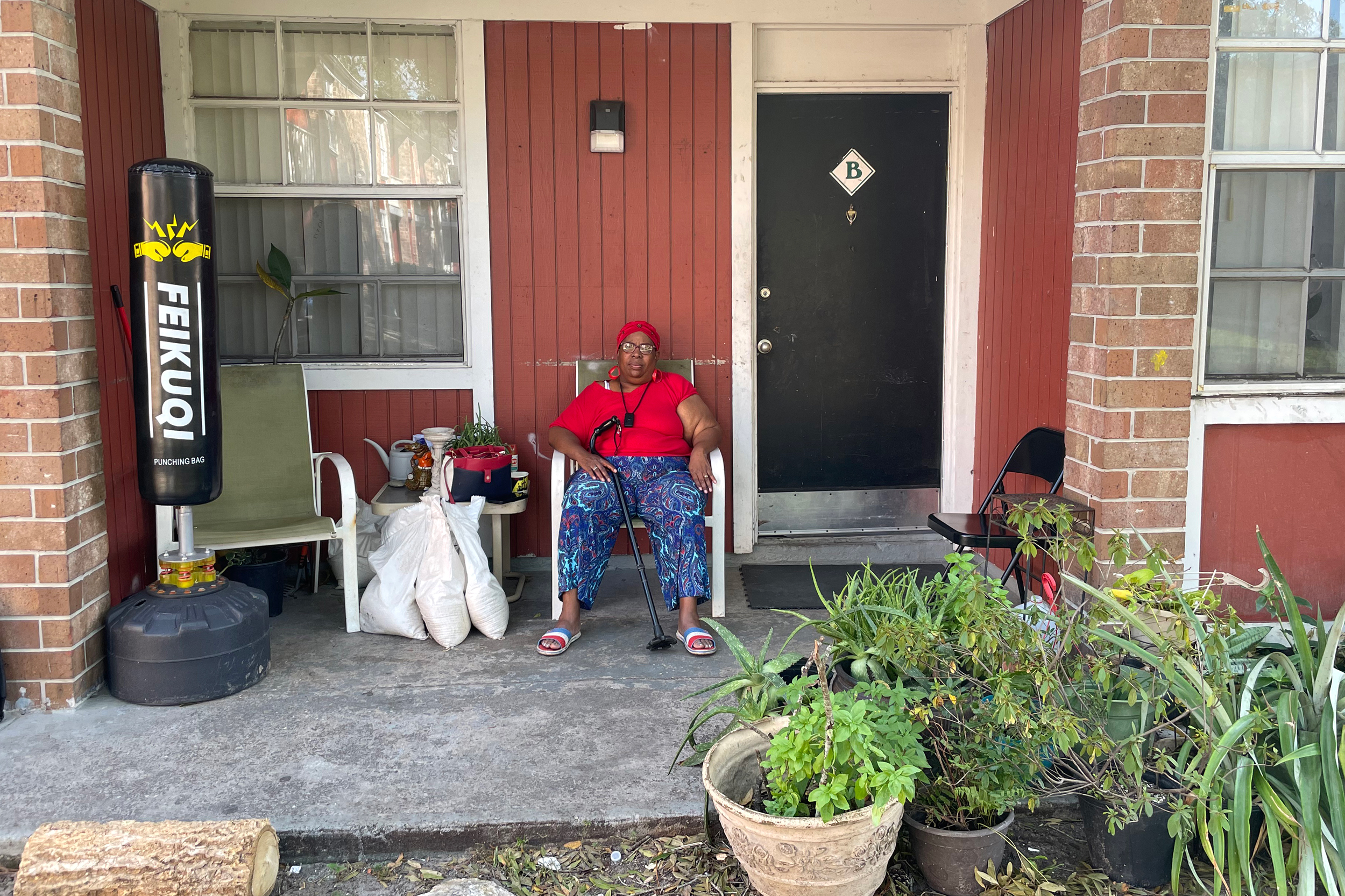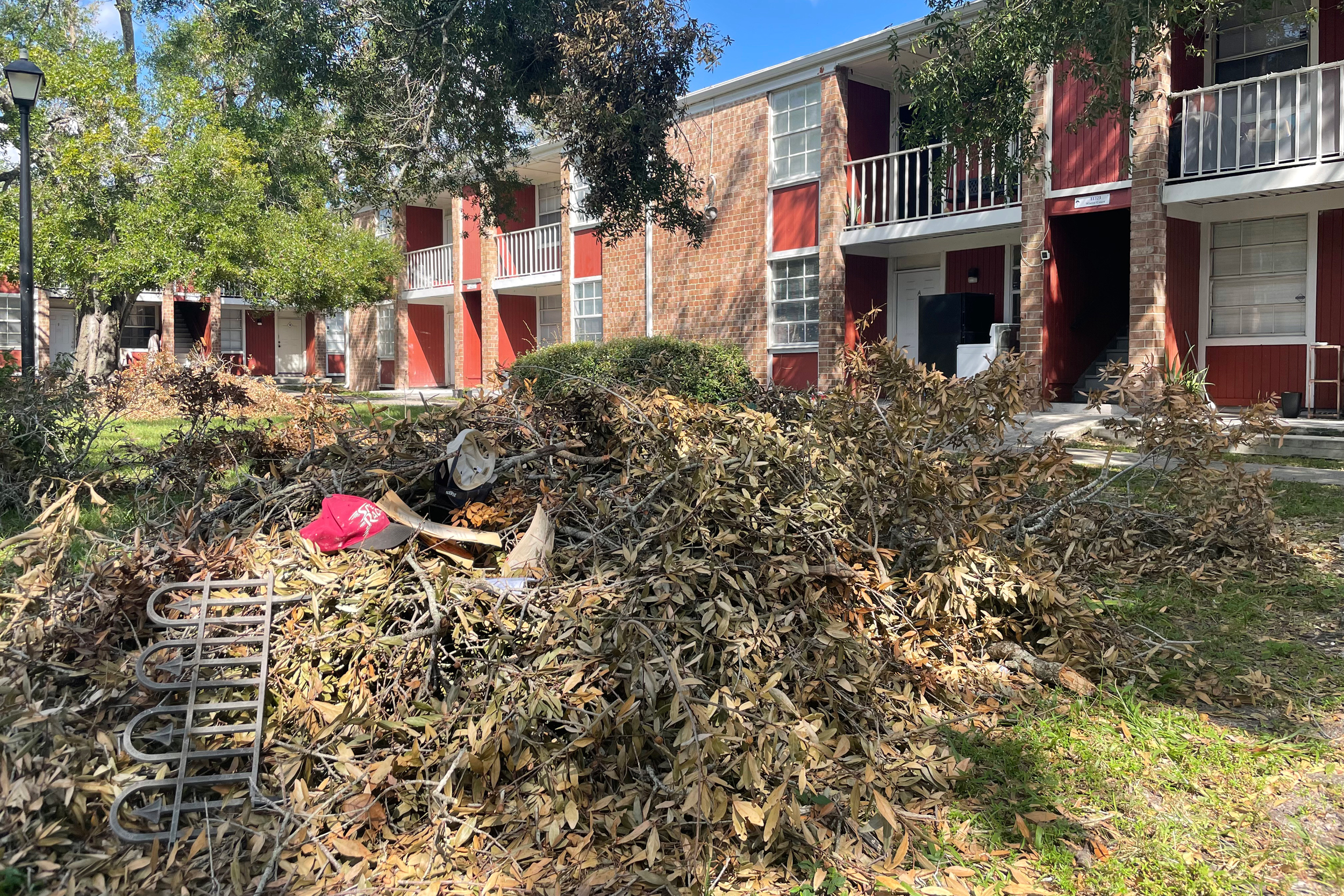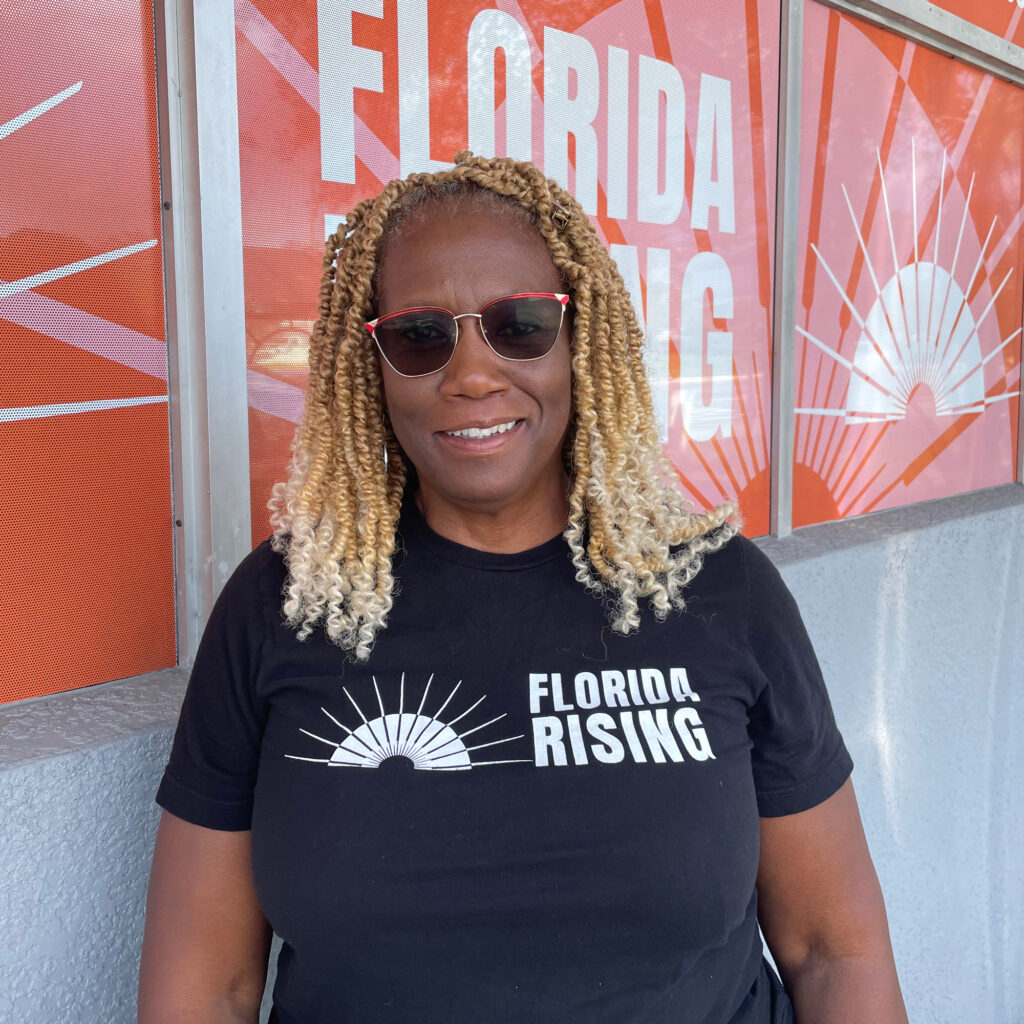After Disasters, Whites Gain Wealth, While People of Color Lose, Research Shows
TAMPA, Fla.—When Hurricane Milton knocked out power to Charlene Love’s apartment for a week, forcing her to toss all the contents of her fridge, she did not eat for two days.
This would be a terrible hardship for anyone. But Love, a warm, round woman who prefers to be called Ms. Love or just Love, suffers from multiple health ailments that have left her disabled, including heart problems and epilepsy. She is due for a second open heart surgery.
“I’m on a fixed income, and when all my food go bad, I cannot go back out and buy that food again,” said Love, 54, who lives in the two-bedroom apartment with her husband and grown son. “I just didn’t eat because there was no food.”
Milton caused widespread wind and flood damage across Florida after making landfall in October 67 miles south of Tampa as a Category 3 storm. The hurricane was the second to strike the state in a mere 13 days, after Helene swirled ashore in northwest Florida as a Category 4 storm, carving out a vast swath of destruction from southwest Florida to western North Carolina.
Explore the latest news about what’s at stake for the climate during this election season.
For Love, Milton left her not only in the dark and starving, a nearby drainage failure forced a rush of water into her red brick and clapboard apartment complex, flooding many of her neighbors’ units. She and her family had positioned sandbags at their front door, sparing their home, but for days, the standing water left the family members stranded, unable to open their door without the deluge coming in. They watched through windows as many of their neighbors were evacuated by first responders on boats.
Love eventually filed a claim for her lost food with the Federal Emergency Management Agency, but weeks after the disaster she had yet to receive a response. Many others in the relatively underserved neighborhood where she and her family reside had already had claims denied, with no reason given, Love and others told Inside Climate News. She said many in her neighborhood felt abandoned.
“It’s very depressing and discouraging because I’m an American. I might be a Black American, but I’m still an American,” she said. “To be treated less than another race is really terrible.”

Growing evidence suggests Love’s discouragement is not unfounded. Research shows that across the nation the system for distributing financial aid after a disaster, aimed at rescuing communities at their most vulnerable, is deepening historical divides along the lines of race, education and homeownership, and that as more damage and assistance accumulate, the disparities worsen.
One 2018 study found that while white residents tend to gain affluence over time after a catastrophe, Blacks and other residents of color lose wealth. In counties where very little damage occurred between 1999 and 2013, researchers found that white residents gained an average of $26,000 in wealth but reaped nearly five times as much, about $126,000, in counties that suffered $10 billion in damage. By contrast, people of other races, who gained wealth in areas spared from significant damage, lost ground in hard-hit places. Black residents in damaged areas lost $27,000 in wealth, Latinos lost $29,000 and people of other races such as Asians lost $10,000.
“White families actually gained more wealth than they would otherwise be expected to if there had been no storm,” said Jim Elliott, co-director of the Center for Coastal Futures and Adaptive Resilience at Rice University and a co-author of the study. “The bigger the damage, the more that’s true.”
The problem leaves the very communities that are the most vulnerable to climate impacts such as hotter temperatures, rising seas and more damaging storms with the least resources for handling them, said Robert Bullard, director of the Bullard Center for Environmental and Climate Justice at Texas Southern University.
He cited the historical practice of redlining, which involved establishing certain neighborhoods as “hazardous” for mortgage lending, based largely on race. Residents of these neighborhoods were denied home loans, leading to lower home values and less homeownership. Legal redlining ended in 1968 with the Fair Housing Act, but the practice has contributed to a legacy of segregation and disparities that remains evident today when it comes to health care, education, incarceration, access to nutritious food and public investment in infrastructure, which would help these vulnerable neighborhoods better withstand high winds and flooding.
“It’s like infrastructure apartheid,” said Bullard, the author of 18 books on urban land use, environmental racism and sustainable development. “Communities that are least likely to get resources first are the same communities that are most likely to not have the basic infrastructure to make them resilient.”
The scope of the problem is far-reaching, extending well beyond Florida’s hurricane-battered coasts. Throughout the last half-century, the average American county has experienced five disasters a year, according to the study Elliott was involved in. Since 2000, virtually no county has been untouched. Researchers predict even higher costs in the future as the warming climate leads to more ruinous calamities such as hurricanes and wildfires.
FEMA administers billions of dollars annually to communities after disasters, while the National Flood Insurance Program is the largest single-line insurance program in the country, providing nearly $1.3 trillion in coverage to more than 5 million policyholders. Private companies insure more than $13 trillion in residential and commercial properties along the Atlantic and Gulf coasts alone, where losses historically have been particularly high and continue to rise, the 2018 study said.

The goal of both kinds of assistance is to re-establish communities by restoring property or wealth, an approach favoring those with more property and the ability to pay for insurance, the study said. These residents may have more access to low-interest loans and significant payouts from public and private insurance policies. Meanwhile, less privileged residents may struggle with job losses and higher rents, as widespread damage leads to housing shortages. The residents also may have to move or dip into meager savings.
“The money will follow money,” Bullard said. “The money will follow power, and the money will follow whites.”
FEMA also offers a program aimed at “managed retreat,” or helping people move away from risky areas. The Hazard Mitigation Grant Program provides funding for local governments to buy out properties vulnerable to flooding. If an owner accepts the government’s offer, the property is demolished and left to nature or used in a flood mitigation project. In recent decades, the program has become a frequent tool for local governments planning for future flood risks.
A 2020 study of more than 40,000 of these buyouts found that while homeowners in neighborhoods with more white residents have more access to the assistance, homeowners in neighborhoods of color are more likely to accept the aid, making these neighborhoods the areas of greatest demolition. Homeowners in white neighborhoods may have more desirable opportunities, the study said. A buyout can take years to complete, often making it an option of last resort when owners can’t sell their homes and values begin to fall.
Elliott, who also co-authored the second study, worried that intensifying climate impacts and growing inequalities would make communities less resilient in the future.
“The real disaster is in the years following the event,” he said. “We begin to split between those who can recover on their own and those who cannot, and those who cannot will fall farther behind.”
He added, “It is heartbreaking, and unless we do something about it soon in a more substantial way, it’s going to get even more so. … We’re on a collision course.”
“FEMA is focused on reducing the barriers people face when accessing our programs, while also ensuring that all disaster survivors receive the assistance for which they qualify for under the law,” according to a statement the federal agency provided to Inside Climate News. “Bottomline, our priority is to make sure all survivors get the assistance for which they qualify under the law.”
The Biden administration has made environmental justice a priority. The administration’s Justice40 Initiative directs federal agencies to dedicate at least 40 percent of environmental cleanup, clean energy and climate mitigation funding to disadvantaged communities. The Inflation Reduction Act of 2022 included tens of billions of dollars for environmental justice.
“The real disaster is in the years following the event. We begin to split between those who can recover on their own and those who cannot, and those who cannot will fall farther behind.”
— Jim Elliott, Center for Coastal Futures and Adaptive Resilience
A National Advisory Council report to the FEMA administrator in November 2020, developed under the Trump administration, acknowledged that recovery programs tend to “provide an additional boost to wealthy homeowners and others with less need, while lower-income individuals and others sink further into poverty after disasters.” The report called for emergency management to be equitable by 2045, with resources going to the most needy.
To achieve this vision, the report recommended, among other things, an “equity standard” to ensure grants enhance equity over time. The document also suggested incorporating diversity, equity and inclusion into FEMA practices, recruiting an inclusive workforce and providing fair and equitable opportunities for professional advancement within the agency.
Already there have been changes. The report pointed out that the Disaster Recovery Reform Act of 2018 enabled FEMA, for instance, to provide more money to those with disabilities when the assistance is necessary for repairs that accommodate wheelchairs. Previously, FEMA would have been legally required to distribute the same funding to everyone.
The federal agency has made other improvements, said Craig Fugate, former FEMA administrator under the Obama administration and former director of the Florida Division of Emergency Management. One problem had been the practice among some families of passing down homes through generations, without changing the deed. The agency now allows additional forms of documentation to prove homeownership, such as a utility bill.
“Since FEMA implemented these changes, tens of thousands of homeowners and renters have received our help. From families recovering from floods in Appalachia or from tornadoes in Mississippi, assistance is now flowing to those who would have previously been denied,” the agency said.
Fugate said FEMA now also offers more assistance to smaller communities that may lack the resources and staff to apply for grants. He characterized the longstanding equity problems as structural.
“The first assumption is that FEMA is doing something wrong, and I’m like, I wouldn’t start with that premise,” he said. “I would ask the question: What is the design of the program, and who is it not reaching? And part of this is legislative.”
Together, Milton and Helene represent the first time two major hurricanes pummeled Florida within the span of two weeks. In central Florida, the flooding still lingers nearly a month after Milton’s landfall, in a few spots along the swollen St. Johns River. The state’s longest river meanders 310 miles to Jacksonville, where it empties into the Atlantic Ocean. An analysis the Environmental Florida Research & Policy Center released on Oct. 25 concluded at least 70 million gallons of pollution, mostly untreated wastewater and sewage, spilled into the state’s waterways and communities as a result of Milton.
The Biden administration has already approved more than $2.3 billion in federal assistance for those affected by the hurricanes in Florida and beyond. The aid includes $1.2 billion for housing repairs and the replacement of personal property, among other recovery efforts. An additional $1.1 billion has been for debris removal and emergency measures to save lives, protect public health and prevent further property damage, FEMA said in a news release.
In Tampa, situated on the Gulf Coast near the peninsula’s center, Helene’s storm surge flooded waterfront neighborhoods, while Milton’s high winds went so far as to nearly rip off the entire roof of Tropicana Field, the domed stadium where the Tampa Bay Rays play baseball. The Florida Division of Emergency Management had been staging at the ballpark in advance of the storm.
Weeks later, the hurricanes’ power and strength remained evident across the metro area, one of the nation’s largest with some 3 million residents. On block after block of east Tampa, characterized by both affluent and underserved neighborhoods, large piles of ruined furniture and yard debris still awaited trash pick-up, the leaves dry and brown. Oak trees were snapped like toothpicks.
“I was amazed, just in awe at how [Milton] destroyed things,” said Robin Lockett, regional director for Florida Rising, a grassroots group representing communities of color. “Just the power of it.”
Since the hurricanes, she has spent her days connecting needy residents with help, working from home while the power was out at her office after Milton. Nine out of 10 of the group’s 150 members had claims denied by FEMA, she said, leaving them without basics such as food and diapers. As many as 1,500 residents lined up for hours at one community event for a meal.
“People are replacing things that they struggle to get in the first place,” she said. “Black people are resilient. It’s the attitude that, ‘I got to do. I got to make a way for myself.’”

She added, “Everybody wants equity, right? Not equal. We want equity. … Equity to me means that even though that 50-50 is given, you’re still not at the same stage as the other party. You may need 70 to get to their 50, and again that extra help is needed.”
Fugate, the former FEMA administrator, refuted concerns that certain groups were not a priority for disaster assistance. He said those whose claims were denied should reapply.
“FEMA does not intentionally deny assistance based upon being low income,” he said. “In fact, as a safety net program that is their primary audience.”
State Rep. Dianne Hart, a Democrat whose district includes east Tampa, said she had heard from dozens of residents whose FEMA claims were denied, including family members. She said some had no insurance because rates in Florida have skyrocketed in recent years.
“For the people who are already poor to be denied, of course that is going to impact them negatively because that means they’ve lost their house or their car, and you’re telling me no, so now what am I supposed to do?” she said. “That means I’m going to have to create some debt in order to buy a car that I have lost in this storm.”
Love said in the absence of resources, her neighbors relied on each other in the aftermath of Milton. They shared whatever food they could scrounge up and gave away clothes and shoes to those who lost everything.
“I feel sometimes when you have Black skin, you got a strike against you,” said Love, dressed from head to toe in red, white and blue, including a red head scarf and striped sandals. “That is really sad in a country like this. And I love my country. I just don’t like the one-sidedness. It’s supposed to be liberty and freedom for all.”
About This Story
Perhaps you noticed: This story, like all the news we publish, is free to read. That’s because Inside Climate News is a 501c3 nonprofit organization. We do not charge a subscription fee, lock our news behind a paywall, or clutter our website with ads. We make our news on climate and the environment freely available to you and anyone who wants it.
That’s not all. We also share our news for free with scores of other media organizations around the country. Many of them can’t afford to do environmental journalism of their own. We’ve built bureaus from coast to coast to report local stories, collaborate with local newsrooms and co-publish articles so that this vital work is shared as widely as possible.
Two of us launched ICN in 2007. Six years later we earned a Pulitzer Prize for National Reporting, and now we run the oldest and largest dedicated climate newsroom in the nation. We tell the story in all its complexity. We hold polluters accountable. We expose environmental injustice. We debunk misinformation. We scrutinize solutions and inspire action.
Donations from readers like you fund every aspect of what we do. If you don’t already, will you support our ongoing work, our reporting on the biggest crisis facing our planet, and help us reach even more readers in more places?
Please take a moment to make a tax-deductible donation. Every one of them makes a difference.
Thank you,
David Sassoon
Founder and Publisher
Vernon Loeb
Executive Editor
Share this article
- Republish
Disclaimer: The copyright of this article belongs to the original author. Reposting this article is solely for the purpose of information dissemination and does not constitute any investment advice. If there is any infringement, please contact us immediately. We will make corrections or deletions as necessary. Thank you.
Title:After Disasters, Whites Gain Wealth, While People of Color Lose, Research Shows
Url:https://www.investsfocus.com










